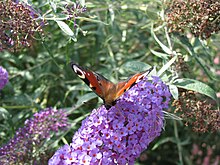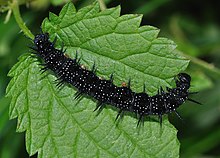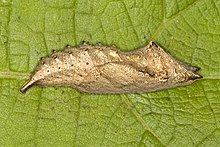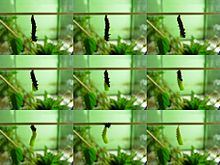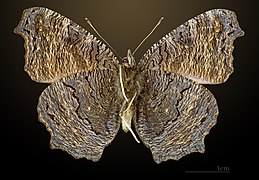Peacock butterfly
| Peacock butterfly | ||||||||||||
|---|---|---|---|---|---|---|---|---|---|---|---|---|

Peacock butterfly ( Aglais io ) |
||||||||||||
| Systematics | ||||||||||||
|
||||||||||||
| Scientific name | ||||||||||||
| Aglais io | ||||||||||||
| ( Linnaeus , 1758) |
The peacock butterfly ( Aglais io , syn .: Inachis io , Nymphalis io ) is a butterfly ( butterfly ) from the family of the noble butterfly (Nymphalidae). The species name is derived from Io , a lover of Zeus from Greek mythology . The peacock butterfly was voted Butterfly of the Year 2009.
features
The moths reach a wingspan of 50 to 55 millimeters. They have a rust-red color of the wings. The unmistakable and most noticeable feature are the black, blue and yellow colored eye spots on each fore and hind wing tip . Those of the forewings are more clearly colored inside with a dark spot. In addition, there are larger black and white spots on the upper edge of the wing, which are closely patterned white and black from the base of the wing to about the middle on the edge. The wing outer edge of both wing pairs is broad gray-brown, as well as the body and the wings around the base. The undersides of the wings are finely marbled in dark gray and black.
The caterpillars are about 42 millimeters long. They are black and white all over the body except for the head and have numerous fine white spots and black thorns.
Occurrence
The distribution area extends from Central Europe over parts of Asia to Japan . In Europe, the north, parts of the Iberian Peninsula and Greece are excluded from the spread . You can find peacock butterfly up to an altitude of 2500 m . They occur in habitats such as open forests , but also in parks and gardens.
Way of life
The peacock butterfly can cope well with modern agriculture as well as with other conditions caused by human intervention. This is promoted by the rapid growth of nettles on nitrogen-rich soils that are well fertilized in accordance with the fertilizer ordinance. To hibernate, the moths look for slightly damp and protected winter quarters, such as caves , cellars or burrows . In attics they dry up due to lack of moisture.
Flight times
The moths fly in two generations every year: the first fly from June to August, with a diapause from July to October depending on the weather , the second generation fly from August to October. After overwintering, the moths can be observed from March to May.
In the afternoon in spring and summer, males of the peacock butterfly defend territories near suitable egg-laying sites. The territorial fights are fought as a kind of competition in the maneuverability of the males. After an argument between two males, either the old one remains in the territory or, after several arguments, the one that proves to be more maneuverable in flight.
Butterflies foraging for food
Peacock butterflies find suitable food plants based on their smell. Peacock butterfly, which has no experience with flowers, prefer the smell of the most important food plants for the species. In response to success or failure in searching for nectar, they adjust their smell preferences. An investigation of the electrophysiological reactions of the antennae to various odor components of butterfly lilac ( Buddleja davidii ) and field thistle ( Cirsium arvense ) showed that the moths also have receptors on the antennae for most of the odor components of these flowering plants.
Food of the caterpillars
In Central Europe, the caterpillars feed almost exclusively on the great nettle ( Urtica dioica ), but they are said to occasionally switch to other nettle species. They rarely feed on real hops ( Humulus lupulus ). The moths that live on the island of Samos , where there are no nettles, feed on upright glassweed ( Parietaria officinalis ).
The caterpillars of the peacock eye usually live on older, low-nitrogen nettles in partial shade. In nature, the females only lay eggs on such plants. Breeding experiments show, however, that the caterpillars of some nettle butterflies ( small fox , peacock butterfly, admiral ) grow faster and achieve higher pupal weights if the caterpillars feed on younger, more nitrogen-rich plants. This means that the caterpillars of peacock butterfly need a longer development time than the caterpillars of the very similar little fox, which in nature usually live on young and sunny stinging nettles.
Predators
As a long-lived butterfly, the peacock butterfly has very effective protection against its predators . In the resting state with folded wings, representatives of this species look more like dry leaves. In the event of imminent danger, a movement program is triggered in which they jerk their wings apart, producing a hissing noise and showing their eye-shaped wing markings. By means of comparative experiments, zoologists at Stockholm University have found that with this defense strategy, the eye signal located on the top of the wing has the greatest deterrent effect against birds. The drawing leads predators to believe that animals are proportionally large to their eyes. In contrast, the hissing noise is particularly effective against mice.
The main enemies of the peacock butterfly are the fly species Sturmia bella and Phryxe vulgaris , which feed parasitically on the caterpillars . But there are also parasitic wasp species that parasitize the pupa of the peacock butterfly.
development
The females lay 50 to 200 eggs on the underside of the leaves of sunny or at most partially shaded, humid and sheltered forage plants. Several females sometimes lay eggs together under the same leaf. The eggs are about one millimeter in size, green and have eight fine longitudinal ribs. After two to three weeks, the approximately three millimeter long caterpillars hatch. They have a white greenish color and a shiny, black head capsule. They live together and shed their skin for the first time after just a few days. Living together in a common web is an effective protection against parasites such as B. parasitic wasps. The then slightly gray-brown caterpillars create a web that then covers the whole plant. After another three moults and, depending on the number of animals, several relocations to new forage plants, they are fully grown and deep black with white spots after a total of three to four weeks. They disperse to pupate on dried up stems or the like in tumbled pupae. You do this by spinning some white threads together into a small pad. They hang on to it with their pushers and can be hung slightly curved. After a day or two, the doll presses through the skin of the back behind the head capsule. The caterpillar skin is stripped upwards and thrown off by circular movements. Before doing this, however, the pupae must hook onto the woven surface with fine hooks at the tip of the abdomen. The young pupae are light green in color that later turns gray-green or brown. The doll also has two rows of shiny thorns and several metal-colored spots. After about two weeks you can already see the wing drawing of the finished butterfly through the slightly transparent doll cover. The moth, starting at the tip, tears it at predetermined seams and forces its way down. Before take-off, the flaccid wings are inflated with blood and air and then harden. Peacock butterflies are ready to mate early on and can produce the next generation.
SEM image of the sensor
Individual evidence
- ^ Arnold Spuler: The butterflies of Europe . tape 1 . E. Schweitzerbartsche Verlagbuchhandlung, Stuttgart 1908, p. 17 .
- ↑ Naturschutzbund: A winner of climate change - The peacock butterfly is "Butterfly of the year 2009"
- ↑ a b c d e f Heiko Bellmann : The new Kosmos butterfly guide. Butterflies, caterpillars and forage plants. Franckh-Kosmos, Stuttgart 2003, ISBN 3-440-09330-1 , p. 170.
- ↑ a b c Tom Tolman, Richard Lewington: The butterflies of Europe and Northwest Africa. Franckh-Kosmos Verlags-GmbH & Co, Stuttgart 1998, ISBN 3-440-07573-7 , pp. 145f
- ^ RR Baker: Territorial Behavior of the Nymphalid Butterflies, Aglais urticae (L.) and Inachis io (L.). Journal of Animal Ecology 41 (2), 1972, pp. 453-469
- ↑ a b Susanna Andersson: Foraging responses in the butterflies Inachis io, Aglais urticae (Nymphalidae), and Gonepteryx rhamni (Pieridae) to floral scents. Chemecology 13 (1), 2003, pp. 1-11, doi: 10.1007 / s000490300000
- ↑ www.lepiforum.de - Aglais io
- ↑ a b c d Wolfgang Düring: Species portrait of the peacock peacock in Rhineland-Palatinate. In: Butterflies in Rhineland-Palatinate. BUND RLP, September 14, 2018, accessed on February 15, 2020 (German).
- ^ Andrew S. Pullin: Changes in Leaf Quality Following Clipping and Regrowth of Urtica dioica, and Consequences for a Specialist Insect Herbivore, Aglais urticae. Oikos, Vol. 49, Fasc. 1, 1987, pp. 39-45 [1]
- ^ Martin Olofsson, Sven Jakobsson, Christer Wiklund: Auditory defense in the peacock butterfly (Inachis io) against mice (Apodemus flavicollis and A. sylvaticus). Behavioral Ecology and Sociobiology 66 (2) 2012, pp. 209-215, doi: 10.1007 / s00265-011-1268-1
literature
- Hans-Josef Weidemann: Butterflies: observe, determine. Naturbuch-Verlag, Augsburg 1995, ISBN 3-89440-115-X .
- Günter Ebert: The butterflies of Baden-Württemberg. Volume 1: Tagfalter I. Ulmer Verlag, Stuttgart 1993, ISBN 3-8001-3451-9 .
